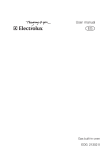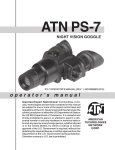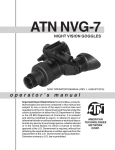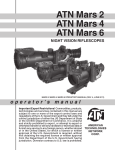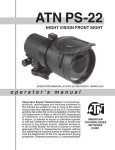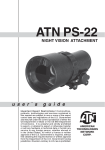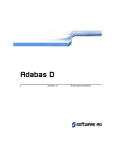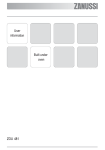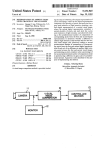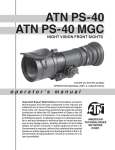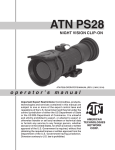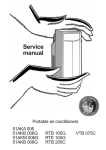Download ATN Voyager 3/5 operator`s manual
Transcript
ATN Voyager 3 ATN Voyager 5 NIGHT VISION bi-oculars voyager 3/ voyager5 operator’s manual (Rev. 1, August 2010) operator’s manual Important Export Restrictions! Commodities, products, technologies and services contained in this manual are subject to one or more of the export control laws and regulations of the U.S. Government and they fall under the control jurisdiction of either the US Department of State or the US BIS-Department of Commerce. It is unlawful and strictly prohibited to export, or attempt to export or otherwise transfer or sell any hardware or technical data or furnish any service to any foreign person, whether abroad or in the United States, for which a license or written approval of the U.S. Government is required, without first obtaining the required license or written approval from the Department of the U.S. Government having jurisdiction. Diversion contrary to U.S. law is prohibited. Register your product warranty online at www.atncorp.com/warranty The information in this manual is furnished for information use only, is subject to change without notice, cannot be construed as a commitment by ATN Corp. ATN Corp. assumes no responsibility or liability for any errors or inaccuracies that may appear in this book. © 2010 ATN Corp. All right reserved. SAFETY SUMMARY STUDY CAREFULLY THIS MANUAL BEFORE TURNING ON AND OPERATING THIS PRODUCT. CAUTIONS Voyager 3x/Voyager 5x night vision bi-oculars are precision electro-optical instruments and require careful handling. Please follow the below instructions of safe use: •Do not disassemble the unit. •Keep the unit clean; protect it from moisture, sudden temperature drops and shocks. •Be careful not to touch the glass surfaces. If you leave fingerprints on, or contaminate the glass surfaces, use only clean and soft materials to clean it. •Protect the unit from excessive lighting. Do not turn the biocular on in daylight with the front lens cap off. Do not point the bi-ocular at the bright light source (a fire, car headlights, lanterns, street lamps, room lights, etc.). • Do not test the device in daylight conditions even with the daylight filter/lens cap on for more than ten (10) minutes. •Do not leave the unit in on position during stops in operation. •Remove the battery from the unit when it is planned to store for over 3 days. Failure to do so may damage the unit. C au tion: This product contains natural rubber latex which may cause allergic reactions. a Equipment Limitations To avoid injuries and equipment damage from using the ATN Voyager 3/Voyager 5, carefully read and consider the following equipment limitations. • The equipment requires some night light (moonlight, starlight, etc.) to operate. The level of equipment performance depends upon the level of light. • Night light reduces by passing through the clouds, while operating under trees, under the shadows of houses, etc. • The device results less effective in peering into shadows and other darkened areas. • The device results less effective in viewing through rain, fog, sleet, snow or smoke. • The equipment will not “see” through the dense smoke. •Its protection system, cuts off the image intensifier when ambient light level continues exceeding of 40 lux for the following 10 seconds. •Under starlight conditions low contrast environments (such as snow-covered territory, sandy deserts, large bodies of water or grassy hills) degrade visibility thereby disguising or masking changes in terrain. •Under too low-light conditions the bi-ocular looses some of the resolution that it has under full moon. b TABLE OF CONTENTS pg. SAFETY SUMMARY a SECTION I. INTRODUCTION 1.1. General 1.1.1. Bi-ocular 1.1.2.Reports 1.1.3. Storage 1.1.4. Warranty 1.2. Description and Data 1.2.1. Description 1.2.2.Voyager Standard Components 1-1 1-2 1-2 1-2 1-2 1-2 1-5 1-5 1-10 SECTION II. OPERATING INSTRUCTIONS 2.1. Installation Procedures 2.1.1. Battery Installation 2.1.2.Neck Strap Installation 2.1.3. Tripod Installation 2.1.4. IR450 Installation 2.2.Operating Procedures 2.2.1. Controls and Indicators 2.2.2.Preparation for Operation 2.2.3. Operation in the Dark Condition 2.2.4.Focusing 2.2.5.Proximity Sensor Operations 2.2.6.Operating at Changing Light Condition 2.2.7. IR Illuminator Operation 2.2.8. Shut-down Operation 2-1 2-2 2-2 2-3 2-3 2-4 2-5 2-5 2-6 2-6 2-7 2-7 2-7 2-8 2-8 SECTION III. OPERATIONAL DEFECTS 3.1. Zeroing Operational Defects 3.1.1. Shading 3.1.2.Edge Glow 3.1.3. Flashing, Flickering, or Intermittent Operation 3.1.4. Cosmetic Blemishes 3-1 3-2 3-2 3-3 3-3 3-3 i SECTION IV. MAINTENANCE INSTRUCTIONS 4.1. Preventive Maintenance Checks and Services (PMcS) 4.1.1.Purpose of PMCS 4.1.2. Frequency of Performing PMCS 4.2. Troubleshooting Procedures 4.3. Maintenance Procedures 4.3.1. Bi-ocular Maintenance 4.3.2.Cleaning Procedures 4.3.3.Preparing for Extended Storage For Technical Information ii 4-1 4-2 4-2 4-2 4-5 4-7 4-7 4-7 4-7 INFO-1 SECTION I introduction 1-1 1.1 General Information 1.1.1. bi-ocular This manual contains instructions for use in the operation and maintenance of the ATN Voyager 3 and Voyager 5. Throughout this manual, the ATN Voyager 3 and Voyager 5 will be referred to as the bi-ocular or the Voyager. 1.1.2. Reports Reports from the user on recommendations for improvements are encouraged. Please send your feedbacks reports to the address below. American Technologies Network Corp. 1341 San Mateo Avenue South San Francisco, CA 94080 (800) 910-2862 (650) 989-5100 (650) 875-0129 fax www.atncorp.com [email protected] 1.1.3. Storage Storage of the Voyager should be done in the factory packing and after a thorough PMCS as outlined in Chapter IV of this manual. This will ensure the bi-ocular remains in mission-ready condition during storage. Battery should be stored separately from the biocular. The Voyager should not be placed on the floor, in any area exposed to high temperatures or direct sunlight. Presence of acid and alkaline vapor, as well as of other aggressive admixtures in the air is unacceptable. 1-2 1.1.4.Warranty 2 Year Product Warranty This product is guaranteed to be free from manufacturing defects in material and workmanship under normal use for a period of 2 (two) years from the date of purchase. In the event a defect that is covered by the foregoing warranty occurs during the applicable period stated above, ATN, at its option, will either repair or replace the product, and such action on the part of ATN shall be the full extent of ATN’s liability, and the Customer’s sole and exclusive remedy. This warranty does not cover a product (a) used in other than its normal and customary manner; (b) subjected to misuse; (c) subjected to alterations, modifications or repairs by the Customer of by any party other than ATN without prior written consent of ATN; (d) special order or “close-out” merchandise or merchandise sold “as-is” by either ATN or the ATN dealer; or (e) merchandise that has been discontinued by the manufacturer and either parts or replacement units are not available due to reasons beyond the control of ATN. ATN shall not be responsible for any defects or damage that in ATN’s opinion is a result from the mishandling, abuse, misuse, improper storage or improper operation, including use in conjunction with equipment which is electrically or mechanically incompatible with or of inferior quality to the product, as well as failure to maintain the environmental conditions specified by the manufacturer. CUSTOMER IS HEREBY NOTIFIED THAT OPERATION OF THE EQUIPMENT DURING DAYLIGHT HOURS OR UNDER ANY EXCESSIVE LIGHT CONDITIONS MAY PERMANENTLY DAMAGE THE INTERNAL COMPONENTS OF THE UNIT AND SAID DAMAGE WILL NOT BE COVERED UNDER THIS WARRANTY. This warranty is extended only to the original purchaser. Any breach of this warranty shall be waived unless the customer notifies ATN at the address noted below within the applicable warranty period. The customer understands and agrees that except for the foregoing warranty, no other warranties written or oral, statutory, expressed or implied, including any implied warranty of merchantability or fitness for a particular purpose, shall apply to the product. All such implied warranties are hereby and expressly disclaimed. Limitation of Liability ATN will not be liable for any claims, actions, suits, proceedings, costs, expenses, damages or liabilities arising out of the use of this product. Operation and use of the product are the sole responsibility of the Customer. ATN’s sole undertaking is limited to providing the products and services outlined herein in accordance with the terms and conditions of this Agreement. The provision of products sold and services performed by ATN to the Customer shall not be interpreted, construed, or regarded, either expressly or implied, as being for the benefit of or creating 1-3 any obligation toward any third party of legal entity outside ATN and the Customer; ATN’s obligations under this Agreement extend solely to the Customer. ATN’s liability hereunder for damages, regardless of the form or action, shall not exceed the fees or other charges paid to ATN by the customer or customer’s dealer. ATN shall not, in any event, be liable for special, indirect, incidental, or consequential damages, including, but not limited to, lost income, lost revenue, or lost profit, whether such damages were foreseeable or not at the time of purchase, and whether or not such damages arise out of a breach of warranty, a breach of agreement, negligence, strict liability or any other theory of liability. Product Warranty Registration In order to validate the warranty on your product, ATN must receive a completed Product Warranty Registration Card for each unit or complete warranty registration on our website at www.atncorp.com. Please complete the included form and immediately mail it to our Service Center: ATN Corporation, 1341 San Mateo Avenue, South San Francisco, CA 94080. Obtaining Warranty Service To obtain warranty service on your unit, End-user must notify ATN service department by calling 800-910-2862 or 650-989-5100 or via e-mail [email protected] to receive a Return Merchandise Authorization number (RMA). When returning please take or send the product, postage paid, with a copy of your sales receipt to our service center, ATN Corporation at the address noted above. All merchandise must be fully insured with the correct postage; ATN will not be responsible for improper postage or, missing or damaged merchandise during shipment. When sending product back, please clearly mark the RMA# on the outside of the shipping box. Please include a letter that indicates your RMA#, Name, Return Address, reason for service return, Contact information such as valid telephone numbers and/or e-mail address and proof of purchases that will help us to establish the valid start date of the warranty. Product merchandise returns that do not have an RMA listed may be refused or a significant delay in processing may occur. Estimated Warranty service time is 10-20 business days. End-user/customer is responsible for postage to ATN for warranty service. ATN will cover return postage/shipping to continental USA end-users/customers after warranty repair only if product is covered by aforementioned warranty. ATN will return product after warranty service by domestic ground service and/or domestic mail. Any other requested, required or international shipping method the postage/shipping fee will be the responsibility of the end-user/customer. 1-4 1.2.Description and Data 1.2.1. Description A. Purpose The Voyager is a powerful night vision bi-ocular with 3X or 5X lens. This bi-ocular is weather resistant and can withstand the rigor of almost any environment. The Voyager will give you the range and clarity that other bi-oculars simply cannot touch. The Voyager is available with a wide range of image intensifier options to meet a wide array of specification requirements. Figure 1-1. Voyager 3 and Voyager 5 Night Vision Bi-oculars B. Features The Voyager has the following important features: • High Quality 2+, CGT, HPT, Gen.3, 3A and 3P image intensifier tube • SMART features and easy-to-use digital controls • 3X or 5X magnification • Super fast, multi-coated, all-glass optics • Dual eye viewing system for long viewing sessions • Detachable long range infra-red illuminator • Rugged and versatile design • Water and fog resistance • Tripod mountable • Hand strap and neck strap for comfort of use • Limited two-year warranty 1-5 C. Principle of Operation The ATN Voyager is a hand-held night vision system that enables walking, short-range surveillance and administering first aid in both moonlight and starlight. The device can be also equipped with an infrared light-emitting source. Bi-ocular utilizes the principle of intensification of the residual light which is reflected from the surrounding objects. The optical system of the monocular consists of: an objective lens, an image intensifier tube and two eyepieces. D. Smart Digital Technology Smart Digital Technology finally provides for the user the total control in the hi-tech industry of night vision. On-board computer systems identify the user’s intention of look through the bi-ocular. When the bi-ocular is brought to the user’s eyes, the bi-ocular will automatically turn on. When removed from the eyes the bi-ocular will turn off (you must engage the Proximity Sensor for this feature to work). The user will never have to worry about turning his or her bi-ocular on or off. Smart series bi-ocular automatically sense when they are no longer used and shut off and enter their sleep mode. Even if your battery is low, don’t worry the Smart Series will let warn you with a light indicator in the FOV. Color coded indicator in the FOV let you know the mode of operation you are using. 1. Proximity Sensor Indicator - when the sensor is ON, the indicator in the FOV will light red. 2. Highlight Protective System Indicator - if the level of light exposure exceeds allowable the indicator will lights green. 3. Low Battery Indicator - when the battery is low the red indicator in the FOV starts blinking. E.Automatic Brightness Control System The device has a built in Automatic Brightness Control. This control automatically adjusts the brightness of image intensifier tube to the optimal level. 1-6 F.Automatic Highlight Protective System The Automatic Highlight Protective System analyzes light exposure with the sensor. If the level of light exposure exceeds allowable the green indicator will light on in the FOV. If high light exposure is kept more than 10 seconds the IIT will automatically turn off. If the unit will move from the bright/excessive light the IIT will turn on again. Caution The system works only when the sensor cap not cover the light sensor. NOTE The protective system indicator will have orange colour when the Proximity Sensor mode is on. NOTE The Automatic Highlight Protective System and Automatic Brightness Control System do not protect a bi-ocular from damage by bright light sources (a fire, headlights of the automobile, lanterns, etc.). Do not point the device at a bright light source. G.Automatic Shut-off System The Automatic Shut-Off System tracks when the unit is not used (the controls are not touched for 60 minutes continuous) and shuts the unit off automatically. H.Low Battery Indicator When red indicator in the FOV starts blinking it is time to change your battery. 1-7 Table 1-1. Specification Mechanical Data: Dimensions (Length x Width x Height) Weight Voyager 3X 8.7”x5.5”x3.1” / 220x140x78 mm Voyager 5X 10”x5.5”x3.4”/ 254x140x86 mm 2.3 lb/1 kg 2.9 lb/1.3 kg Electrical Data: Battery One AA (1.5 V) or CR123A (3 V) Cell Life at 20 ˚C: AA Alkaline Battery 123A Lithium Battery Optical Data: Magnification Objective Lens Focal Length Objective Lens F/number 30 hours 60 hours Voyager 3X Voyager 5X 3X 5X 70 mm 108 mm 1:1.5 1:1.5 Field of View 14° 9.5° Focus Range 3 m to infinity 5 m to infinity Diopter Adjustment Exit pupil Eye relief Interpupillary Distance ±5 14 mm 17 mm 58 - 72 mm Environmental Data: Operating Temperature -40 to +50 ˚C Storage Temperature -50 to +70 ˚C Illumination Required Natural nighttime illumination (overcast starlight to moonlight) 1-8 ON/OFF Button Proximity Sensor Button Eye Cups Sensor of Highlight Protective System with cap Top Rail Battery Housing Cap Objective Lens Focus Lens Cap with IR filter Proximity Sensor Hand Strap Diopter Adjustment Rings Neck Strap’s Buckles Bottom Rail with Tripod Socket Figure 1-2. Voyager Controls and Main Elements 1-9 1.2.2.voyager Standard Components The Voyager standard components are shown in Figure 1-3 and presented in Table 1-2. 1 3 2 6 5 7 8 4 9 10 11 Figure 1-3. Voyager Standard Components Table 1-2. Voyager Standard Components DESCRIPTION ITEM QTY 1 ATN Voyager Bi-ocular 1 2 Objective Lens Cap 1 3 Eye Cups 2 4 Cap of Highlight Protective System Sensor 1 5 Hand Strap 1 6 Battery Adapter 1 7 CR123A, Lithium Battery 1 8 IR450 Infra-Red Illuminator Kit 1 9 Neck Strap 1 10 Operating Manual 1 11 Soft Bag 1 1-10 IR Illuminator Kit is shown in Figure 1-4 and listed in Table 1-3. 1 2 3 4 Figure 1-4. IR450 IR Illuminator Kit Table 1-3. IR450 Kit ITEM DESCRIPTION QTY 1 IR450-B4 Illuminator 2 CR123A type battery 1 1 3 1.5 mm Allen Key 1 4 IR450 Wrench 1 STANDARD COMPONENTS 1)ATN Voyager Bi-ocular The bi-ocular night vision device with 3x or 5x magnification. 2) Objective Lens Cap Lens cap with IR Filter used to protect the lens and for testing the unit in the daylight. 3) Eye Cups Rubber cups used to protect eyepiece and for operator comfort. 4)Cap of Highlight Protective System Sensor The cap deactivates the sensor of Highlight Protective System for operating at changing light conditions. 5) Hand Strap Enables to keep the Voyager in the hand for comfortable us. 6)Battery Adapter Allows the ATN Voyager to accept the CR123A Lithium and AA size batteries to power the unit. Installed in the battery cap in CR123A usage position. 7)CR123A, Lithium Battery CR123A lithium batteries used to power the unit. 1-11 8) IR450 Infra-Red Illuminator Kit Powerful 450mW detachable infra-red illuminator is an efficient tool for long range nighttime observation in the total darkness. 9) Neck Strap 0)Operating Manual 1 Provides equipment description, use of operator controls and preventative maintenance checks and service. 11) Soft Case A protective case used to store Voyager and accessories. 1-12 SECTION II operating instructions 2-1 2.1.Installation Procedures 2.1.1. Battery Installation A. Install CR123A battery as follows: With the battery adapter screwed in the battery housing cap as shown on Figure 2-1 you can use one CR123A type battery. Put the CR123A battery observing the polarity indications on the battery compartment surface. battery housing cap battEry adapter CR123A type battery Figure 2-1. AA type battery installation B. Install AA standard battery as follows: To install a AA one, take the battery adapter out of the battery housing cap, turn it over, and screw its smaller threading into the same battery cap. Now you can put the AA battery observing the polarity indications on the battery compartment surface. battery housing cap battEry adapter AA type battery Figure 2-2. CR123A type battery installation 2-2 2.1.2. neck strap Installation Pass the end of the strap through the bi-ocular’s strap mount eyelet from the bottom. Then pass it through the strap’s buckle as shown in the Figure 2-3. Pull the strap to take up any slack and make sure the strap will not loosen from the buckle. Figure 2-3. Neck strap installation 2.1.3. tripod Installation Voyager can be used on the tripod. To install the tripod, screw it in the 1/4” threaded socket of bottom rail of Voyager. NOTE Severe damage to the unit can occur if the tripod collapses or is knocked over. It is recommended that the Voyager be removed if the user is not within arm’s reach of the tripod. 1/4” tripod socket Figure 2-4. Tripod installation 2-3 2.1.4. IR-450 installation IR-450 detachable infrared illuminator can be mounted on the top or bottom rail of bi-ocular. 1. Loosen the IR-450 fixing screw. 2. Mount the IR-450 on the rail of Voyager and tighten the fixing screw. fixing screw Figure 2-5. IR450 installation 2-4 2.2.Operating Procedures 2.2.1.Controls and indicators The Voyager is designed to adjust for different users and corrects for most differences. The controls of the bi-ocular are shown on Figure 2-6. The functions of controls and indicators are described in the Table 2-2. ON/OFF Button Diopter Adjustment Rings Proximity Sensor Button Proximity Sensor Sensor of Highlight Protective System with cap Objective Lens Focus Figure 2-6. Voyager Controls Table 2-2. Voyager Controls and Indicators CONTROLS FUNCTION ON/OFF Button Controls unit power. To turn the unit on and off press the button. Proximity Sensor Button Controls Proximity sensor. To turn the sensor on and off press the button. Objective Lens Focus Focuses objective lens. Adjusts for sharpest image of the viewed object. Diopter Adjustment Focuses eyepiece lens to use the unit without glasses. Adjusts for sharper image of intensifier screen. 2-5 CONTROLS FUNCTION Sensor of Highlight The automatic Highlight Protective System anaProtective System lyzes light exposure with the sensor. Proximity Sensor Identifies the user’s intention to look through the bi-ocular by turning the unit automatically on. When Proximity sensor is ON, the indicator in the FOV will lights red. Indicator in FOV If the level of light exposure exceeds allowable the indicator will lights green. When the battery is low the red indicator in the FOV starts blinking. 2.2.2.preparation for Operation To check the device in the daytime conditions or in the light room: 1. Make sure the battery is installed as indicated on the bi-ocular body. 2. Make sure the lens cap is attached to the front lens and Protective System sensor cap covers the sensor. 3. Turn on the device by pressing ON-OFF button. After this you can start observing scene through the oculars. The greenishlit screen of the image tube means that the device is working normally. 4. Direct the bi-ocular at an object located 15-25 yards/m from you and obtain a sharp image by turning eyepieces (see section 2.2.3). 5. Turn off the device by pressing ON-OFF button again. CAUTION Never use your night vision device in daylight areas without the lens cover on! Never direct the lens to the bright light! 2.2.3. Operations in the dark conditions CAUTION Bright sources such as light of fire, headlights, searchlights, 2-6 etc. can damage the Voyager. Avoid exposing the Voyager to these types light sources. To start the operations in dark conditions: 1. Make visual estimation if the illumination level in the viewing area is less than 1 lux (late twilight sky conditions). 2. Remove the Protective System sensor cap. CAUTION Ensure the sensor is open before removing the lens cap. 3. Remove the front lens cap and place it over the objective. 4. Push the ON/OFF button. A green glow will appear in the eyepiece (after a slight delay). 5. Observe the scene and adjust focus. 2.2.4.focusing To focus the Voyager, first you will need to adjust the diopters. Simply turn the diopter adjustment rings clockwise until it stops. Then, while looking through the eyepieces at an object, slowly turn the adjustment rings counter-clockwise until the grain in the image is sharp. 2.2.5.proximity sensor operations To turn the Proximity Sensor on press the Proximity Sensor button marked “A”. The indicator in the FOV will lights red. SMART systems identify the user’s intention to look through the bi-ocular. When the bi-ocular is brought to the user’s eyes, the bi-ocular will automatically turn on. When removed from the eyes the bi-ocular will turn off. To turn the Proximity Sensor off, press the Proximity Sensor button again. The red light indicator in the FOV will out. 2.2.6. Operating at Changing Light Conditions The bi-ocular has a high light protective system, which cuts off the image intensifier when ambient light level exceeds the limit of 40 lux during 10 seconds. If a mission has to be carryed out at 2-7 changing light conditions, it is possible to shut down the protective system. Put the rubber cap onto the light sensor (Figure 2-7). SENSOR OF HIGH LIGHT PROTECTIVE SYSTEM SENSOR CLOSED WITH CAP Figure 2-7. HIGH LIGHT PROTECTIVE SYSTEM SENSOR 2.2.7.ir illuminator operation Infra-red (IR) Illuminators are common for night vision technology. The IR light greatly enhances the performance of your device, while remaining almost totally invisible to the naked eye. Staying in the dark, switch on your night vision device. If the visibility is low, you may use ATN IR450 to improve the situation. Still, you should remember that the IR illuminator is just a source of infrared light so the greater is the chosen range of observation, the lesser its brightness becomes. IR BRIGHTNESS ADJUSTMENT POWER LED INDICATOR IR ELEVATION ADJUSTMENT NUT IR FOCUSING FIXING NUT IR WINDAGE ADJUSTMENT BATTERY HOUSING WRENCH ALLEN KEY Figure 2-8. IR450 Illuminator 2-8 BATTERY HOUSING CAP IR450 Infrared Illuminator can be mounted with Voyager onto the Picatinny rail. The ATN IR450 is powered with one CR123A lithium battery. To install the battery unscrew the cap of the battery housing and insert the battery following the polarity arrows marked on the housing. Put the cap in place. The IR-450 illuminator has a control panel with two buttons. To switch the IR illuminator on/off press “+” and “-” buttons simultaneously. When the IR illuminator is switched on you can see the green LED lit on the back side of IR450. By pushing the buttons “+” and “-” you may adjust the IR brightness. The IR beam is focusable to change the field of coverage. To change the beam width slightly turn the IR lens. You may need adjust the focusing of the IR beam to change the field of coverage. Do it by slightly rotating the IR lens. The windage and elevation screws help adjust Wrench the direction of the IR beam from the IR450 in order to focus on the To Loosen Nut scene observed in the viewfinder of your device. Use the included Allen wrench to rotate the adControl Panel To Tighten justing screws until the IR beam Nut is centered. Please remember the adjustments should be perNut formed under night light conditions only. You can change the position of the IR control panel to meet your your needs. The wrench that is Figure 2-9. CHANGING OF included in the set, is used to CONTROL PANEL POSITION loosen the nut located on the body of the IR. Rotate the IR to the desired position. Tighten the nut with the wrench to secure the new position. 2-9 2.2.8. Shut-down operations 1. Push ON/OFF button to turn the bi-ocular off. The green of the image intensifier tube glow will fade to black. 2. Replace the protective cap on the front lens. 2-8 SECTION III OPERATIONAL DEFECTS 3-1 3.1. ZEROING OPERATIONAL DEFECTS Operational defects refer to the reliability of the image intensifiers and are an evidence of instability. Their identification shall be a valid reason to immediately refuse to accept the ATN Voyager. These include shading, edge glow, flashing, flickering, and intermittent operation. 3.1.1. Shading If shading is persistent, you will not see a fully circular image (Figure 3-1). Shading is very dark and you cannot see an image through it. Shading always begins on the edge and migrates inward eventually across the entire image area. Shading is a high contrast area with a distinct line of demarcation. Contact ATN or point of purchase for warranty/repair procedures. SHADING Figure 3-1. Shading NOTE Make sure the shading is not the result of improper exit pupil position. 3-2 3.1.2. Edge Glow Edge glow is a bright area (sometimes sparkling) in the outer portion of the viewing area (Figure 3-2). To check for edge glow, block out all light by cupping a hand over the lenses. If the image tubes are displaying edge glow the bright area will still show up. Contact ATN or point of purchase for warranty/repair procedures. EDGE GLOW Figure 3-2. Edge Glow 3.1.3. Flashing, Flickering, or Intermittent Operation The image may appear to flicker or flash. If there is more than one flicker, check for loose battery adapter or weak battery. Contact ATN or point of purchase for warranty/repair procedures. 3.1.4. Cosmetic Blemishes These are usually the result of manufacturing imperfections that do not affect image intensifiers reliability and are not normally a reason to claim for warranty or repair work. However, some types of blemishes can get worse over time and interfere with the usability of the device. If you believe a blemish is a cause for rejection, warranty or repair please ATN or point of purchase for warranty/ repair procedures. 3-3 A. Bright Spots. A bright spot is a small, non-uniform, bright area that may flicker or appear constant (Figure 3-3). Not all bright spots make the ATN Voyager rejectable. Cup your hand over the lenses to block out all light. If the bright spot remains, return the ATN Voyager. Bright spots usually go away when the light is blocked out. Make sure any bright spot is not simply a bright area in the scene you are viewing. Bright spots are acceptable if they do not interfere with the ability to view the outside scene. B. Emission Points. A steady or fluctuating pinpoint of bright light in the image area and does not go away when all light is blocked from the objective lenses of the bi-ocular (Figure 3-3). The position of an emission point within the image area does not move. Not all emission points make the ATN Voyager rejectable. Make sure any emission point is not simply a point light source in the scene you are viewing. Emission points are acceptable if they do not interfere with the usability of the device. EMISSION POINT BRIGHT SPOT Figure 3-3. Bright Spots and Emission Points 3-4 C. Black Spots. These are cosmetic blemishes in the image intensifiers or dirt or debris between the lenses. Black spots are acceptable as long as they do not interfere with viewing the image. No action is required if this condition is present unless the spots interfere with the usability of the device. D. Fixed-Pattern Noise. This is usually a cosmetic blemish characterized by a faint hexagonal (honeycomb) pattern throughout the viewing area that most often occurs at high light levels or when viewing very bright lights (Figure 3-4). This pattern can be seen in every image intensifier if the light level is high enough. This condition is acceptable as long as the pattern does not interfere with viewing the image and usability of the device. Figure 3-4. Fixed-Pattern Noise 3-5 E. Chicken Wire. An irregular pattern of dark thin lines in the field of view either throughout the image area or in parts of the image area (Figure 3-5). Under the worst-case condition, these lines will form hexagonal or square-wave shaped lines. This is typically viewed in high light conditions. No action is required if this condition is present unless it interferes with the viewing the image and interferes with the users usability of the device. Figure 3-5. Chicken Wire 3-6 SECTION IV maintenance instructions 4-1 4.1. Preventive Maintenance Checks and Services (PMCS) 4.1.1. Purpose of PMCS PMCS is performed daily when in use to be sure that the Voyager is ready at all times. Procedures listed in Table 4-1 are a systematic inspection of the Voyager that will enable you to discover defects that might cause the device to fail on a mission. 4.1.2. Frequency of performing PMCS The frequency of performing PMCS is as follows: 1.Daily when the Voyager is in use. 2.When it is removed from the case for any reason. Table 4-1 Preventive Maintenance Checks and Services SEQ. NO. 1 LOCATION ITEM TO CHECK/ SERVICE Maintenance PROCEDURE Open carrying case, inventory items. Previously recorded faults on maintenance records. NOT FUNCTIONING AT OPTIMAL LEVEL IF Not Current. Fault not corrected. Bi-ocular 4-2 2 Optical Surfaces Inspect lenses for dirt, fingerprint residue, chips, or cracks. If necessary, clean and dry lens with water and lens tissue. 3 External Surfaces Inspect for cracks or damage. Scratches and gouges are OK if operation is not affected Scratches or chips hinder vision with goggles turned on, or if cracks are present. Cracked or damaged. SEQ. NO. LOCATION ITEM TO CHECK/ SERVICE 4 Battery Adapter / Compartment Check to make sure battery adapter is present. Remove battery adapter and inspect for corrosion, moisture, corroded or defective contacts. Adapter is missing, contacts damaged or corroded. 5. Diopter Adjustment Rings Rotate diopter adjustment ring to make sure the eyepiece is not too tight or too loose. Binding, not moving freely or too loose. 6 Eyecups Inspect for dirt, dust, and cracked or torn cups. Inspect for bent, broken or improperly fitting eyecups. If necessary, clean with water. 7 Objective Lens Focus Ring Rotate objective lense focus rings to ensure free movement. 8 Lens Cap Inspect for cracked, torn, or missing lens cap. 9 Viewed Image Refer to Section III – Operation Defects – to inspect for operational defects. Flickering, flashing, edge glow, or shading is observed. 10 Hand Strap Inspect for cuts, tears, fraying, holes, cracks, or defective fasteners. Damage causes straps to be unserviceable. 11 Neck Strap Inspect for cuts, tears, or excess wear or damaged clips. PROCEDURE NOT FUNCTIONING AT OPTIMAL LEVEL IF Binding or not moving freely. 4-3 SEQ. NO. LOCATION ITEM TO CHECK/ SERVICE 12 Mounting Rail Inspect for dirt, dust, or corrosion. If necessary, clean socket with water. Carrying Case Remove all items and shake out loose dirt or foreign material. Inspect for tears, cuts, excess wear or damage to mounting clips. 13 4-4 PROCEDURE NOT FUNCTIONING AT OPTIMAL LEVEL IF 4.2. TROUBLESHOOTING Procedures Table 4.2. lists common malfunctions that you may find in your equipment. Perform the tests, inspections, and corrective actions in the order they appear in the table. This table cannot list all the malfunctions that may occur, all the tests and inspections needed to find the fault, or all the corrective actions needed to correct the fault. If the equipment malfunction is not listed or actions listed do not correct the fault, notify ATN or your point of Purchase. Table 4-2. Troubleshooting Procedures for VOYAGER SEQ. NO. 1 2 3 MALFUNCTION TEST OR INSPECTION Bi-ocular fail to activate. Push ON/OFF button. Poor image quality Check objective lenses or eyepieces focus. Check for fogging or dirt on lenses. Light visible around eyecups Check eye-relief distance. Check eyecups for resiliency. Check for defective, missing or improperly installed batteries. CORRECTIVE ACTION Push ON/OFF button again. Replace the battery or install it in a proper way. Refocus. Clean lenses surface tightly. If image quality is still poor, refer to higher level of maintenance. Press the eye cups to face If eyecups are defective, refer to higher level of maintenance. 4-5 SEQ. NO. 4-6 MALFUNCTION TEST OR INSPECTION 4 Diopter adjustment cannot be made Check to see if the diopter adjustment rings are bent or broken If damaged, refer to higher level of maintenance. 5 Battery adapter difficult to remove. Check for damaged battery adapter. If damaged, refer to higher level of maintenance. 6 IR illuminator fails to activate. In a dark location with system turned on, activate IR. Visually check IR illuminator operation; scene should brighten. CORRECTIVE ACTION If IR illuminator fails to activate, refer to higher level of maintenance. 4.3.Maintenance Procedures 4.3.1. bi-ocular Maintenance The Voyager maintenance consists of external inspection of its components for serviceability, cleaning and installation of the standard and optional accessories. Maintenance instructions covered elsewhere in this manual (PMCS, troubleshooting, etc.) are not repeated in this section. CAUTION The Voyager is a precision electron-optical instrument and must be handled carefully at all times to prevent damage. 4.3.2. Cleaning Procedures 1.Gently brush off any dirt from the bi-ocular body using only a clean soft cloth. 2.Moisten the cloth with fresh water and gently wipe the external surfaces (except lenses). 3.Dry any wet surfaces (except lenses) with another dry and clean soft cloth. 4.Using lens brush, carefully remove all loose dirt from the lenses. 5.Slightly dampen a cotton swab with ethanol and lightly and slowly wipe the lenses. Clean the glass surfaces by circular movements from the centre to the edge, not touching the lens holder and changing cotton swab after each circular stroke. Repeat this step until the glass surfaces are clean. CAUTION Dry thoroughly each item before replacing into the storage case. 4.3.3. Preparing for Extended Storage To prepare the Voyager for extended storage, perform the following: 1.Check the bi-ocular for serviceability as outlined in item 4.1 of this manual. 2.Remove the batteries. 4-7 3.Clean the bi-ocular and accessories. 4.Replace all items in the case. 4-8 APPENDIX A (Reference) ESTIMATION OF AMBIENT ILLUMINATION LEVEL Table A-1. Standard Natural Light Conditions and Illumination Values STANDARD NATURAL LIGHT CONDITIONS ILLUMINATION VALUE, LUX Quarter moon 0.05 Full moon 0.30 Late twilight sky 1.00 Twilight sky 10.00 Overcast sky in the daytime 500.00 4-9 APPENDIX B spare PARTS LIST The Spare Parts List is an illustrated catalog of main parts and assemblies completing the Night Vision Bi-ocular Voyager, here in after referred to as Voyager. Therefore, in case of failure of any part or assembly User could replace it by ordering the corresponding part/assembly from the Spare Parts List. The amount and assortment of the spare parts needed should be arranged with each contract individually. Table B-1. ATN VOYAGER 3/5 spare parts list PART NO. DESCRIPTION FIG. ITEM AT 201222.701 Eye Cups B1 1 AT 201222.702 Voyager 3 Bi-ocular B1 2 AT 201223.702 Voyager 5 Bi-ocular AT 201222.703 Objective Lens Cap for Voyager 3 B1 3 AT 201223.704 Objective Lens Cap for Voyager 5 AT 201222.705 Cap of Highlight Protective System Sensor B1 4 AT 201222.706 Hand Strap B1 5 AT 201222.707 Battery Adapter B1 6 CR123A CR123A Battery B1 7 AT 146542.710 IR 450 Kit B1 8 AT 201222.712 Soft Carrying Case B1 9 AT 201222.713 Operators Manual B1 10 AT 201222.714 Neck Strap B1 11 4-10 2 1 3 8 6 5 7 4 9 10 11 Figure B-1. NIGHT VISION bi-ocular and aCCESSORIES 4-11 4-12 For Technical Information ATN Corp. 1341 San Mateo Avenue South San Francisco, CA 94080 (800) 910-2862 (650) 989-5100 tel. (650) 875-0129 fax 24042012 www.atncorp.com [email protected] INFO-1 For customer service and technical support, please contact American Technologies Network Corp. North American Office 1341 San Mateo Avenue, South San Francisco, CA 94080 phone: 800-910-2862, 650-989-5100; fax: 650-875-0129 European Office The following countries can use our toll free number: 00 800 9102-8620 Austria, France, Germany, Holland, Italy, Spain, Sweden, Switzerland For other countries, please use 38 048-7770214 or 38 048-7770345 www.atncorp.com ©2010 ATN Corporation
















































